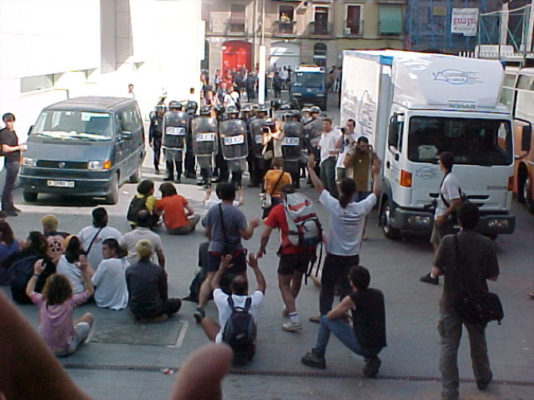Search
To search for an exact match, type the word or phrase you want in quotation marks.
A*DESK has been offering since 2002 contents about criticism and contemporary art. A*DESK has become consolidated thanks to all those who have believed in the project, all those who have followed us, debating, participating and collaborating. Many people have collaborated with A*DESK, and continue to do so. Their efforts, knowledge and belief in the project are what make it grow internationally. At A*DESK we have also generated work for over one hundred professionals in culture, from small collaborations with reviews and classes, to more prolonged and intense collaborations.
At A*DESK we believe in the need for free and universal access to culture and knowledge. We want to carry on being independent, remaining open to more ideas and opinions. If you believe in A*DESK, we need your backing to be able to continue. You can now participate in the project by supporting it. You can choose how much you want to contribute to the project.
You can decide how much you want to bring to the project.

For a while now, I’ve wanted to rescue an event that marked a before and after in the history of art activism in Spain, but couldn’t find an opportune moment, until a week ago. Leónidas Martín (from the collective “Enmedio”) gave the seminar Artivism: art and politics in connected societies, in the lecture-hall of ESDi (Barcelona). Starting off with a long list of precedents in art activism that now configure his modus operandi, he ended up placing special emphasis on one of the more interesting, and incomprehensibly little studied, projects in the history of protest art, one that has become the focus of my current research: “Las Agencias”.
“Las Agencias” stemmed from various workshops carried out at MACBA in 2001, led by Jordi Claramonte (from the collective “la Fiambrera Obrera”) and Jorge Ribalta (in charge of the Department of Public Programmes), prior to the celebration of the summit of the World Bank in Barcelona. Seeking the complicity of collectives active in creation and in social movements, they worked as mediators to reach spaces of experimentation that the museum, on its own, couldn’t have accessed. The project arose in order to grant them independence and autonomy, while taking advantage of some of the resources of the institution, to establish a broad collaborative network between professionals and amateurs. At the same time this dialectic served as an exercise of self-critique for the museum: fundamental to avoid settling into a rigid hierarchical structure.
There were disagreements from the beginning of the workshop: the impossibility of “Counter-information” setting up a debate (with the participation of squatter groups) about urban speculation in the actual facilities of MACBA (a symbol of such speculation in the Raval); the precariousness of the means offered by the museum; the lack of accommodation for the participants…The museum also didn’t remain quiet: recriminating the participants for not having asked permission before copying and distributing amongst themselves keys to the workshops where they were working; or manifesting a certain fear that the computers and internet they had loaned could be used for “activities that could be defined as illegal”.
These workshops for agency were resolved with a “show” of the projects realised (Prêt-a-revolter suits, stickers with Free Money, the Show Bus…) in a demonstration in the centre of the city. Such visibility, accompanied by much hoo-ha, ended up with a more than foreseeable police charge on those in the street, as much as on those who had sought refuge in the old café of MACBA (that ended up totally destroyed). Many of the participants in “Las Agencias” were charged and taken to the police station, while the museum’s management protected themselves from any blows behind the walls of the CCCB. This event, along with the fact that the press had previously spread the opinion that the museum was sheltering activities of dubious legality, served as the trigger for the Consortium of MACBA (the Town Council, the Generalitat and the Foundation of the museum) to give a wake-up call to Manuel Borja-Villel, one effective enough to curb the continuity of “las Agencias”. Demands were made for Jorge Ribalta to be fired and even the director’s head was under threat, but they had a lifebelt: the Consortium had given their prior approval to this project, so they could only complain and restrict “part” of the liberty of “las Agencias” (consequently many of them refused to carry on participating with the museum). The catalogue, Relational Objects. MACBA collection 2002-2007 relates some of the facts of the official version, a very watered down version of what actually took place.
This was all almost twelve years ago now, and it is interesting to analyse how both sides have evolved and what this event meant for the undertaking of certain projects at the moment. The institution of the museum still collaborates with collectives: albeit, on a small scale and in a much more mediated fashion than “las Agencias”. On the part of artivism, these events have left a rich legacy regarding transformative methodologies and new languages with which to intervene in society…A few examples of direct influence would be the collective “Enmedio” or the “CCCB” (Centre for Contemporary Cultivation of the Barrio). In any event, it is still interesting today to study the ways in which an institution relates to its surroundings. Does it merely show them or does it also learn from these interactions?
To be continued.

Alba Benavent is an eternal apprenticeship. An art historian, she observes the artistic world under a curious as well as analytical look. Research has always been his favorite subject. With a restless mind, almost as much as his feet, he proposes to make the intricacies of the artistic bar from the reflection around the different performances of his agents more accessible. She writes the blog elchiringuitodelarte.
"A desk is a dangerous place from which to watch the world" (John Le Carré)